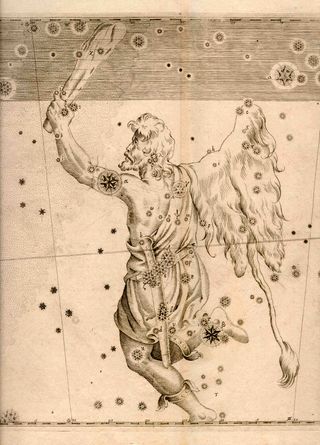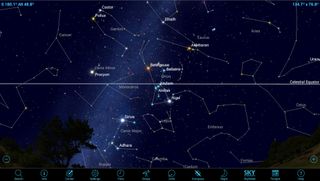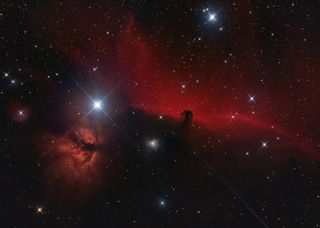Exploring Orion's Wonders Using Mobile Astronomy Apps

Every year at this time, the evening sky is dominated by the eye-catching constellation Orion, the hunter, and his famous three-starred belt. The constellation contains some of the sky's most spectacular sights within reach of the naked eye, binoculars or telescopes of any size. Orion's spectacular stars and the bright nebulas in his sword and belt are well worth a look on chilly winter nights.
Your favorite mobile astronomy app can help you find them and see what they look like, even if you don't own a telescope. Let's bundle up against the winter chill and tour Orion's wonders.
Where's Orion?
The constellation of Orion, the hunter is well-known for several reasons. First, it straddles the celestial equator, making it visible throughout the world. Second, most of its stars are bright enough to see with unaided eyes, even under light-polluted skies. And finally, the constellation readily evokes a human figure, making it recognizable. [14 Best Skywatching Events of 2017]

Traditionally, Orion has been depicted as kneeling or standing, with his eastern arm raised and bearing a club. His other arm is outstretched to the west and holds a cloak, a lion's pelt or a shield. His name comes from Greek mythology. In one story, to prevent the great hunter from killing her beloved animals, Gaia, the goddess of Earth, sent a scorpion to kill him. Ophiuchus, the serpent bearer, cured Orion, and the scorpion, now called Scorpius, was placed on the opposite side of the sky, never to be visible at the same time as Orion. Ophiuchus was placed midway between the two foes. The constellations of Gemini and Taurus sit above Orion, to his upper left and right, respectively. Beneath his feet, his faithful dog, Canis Major, chases the rabbit Lepus.
Orion is a medium-size constellation, measuring 30 degrees (three outstretched fist widths) high, from his upraised club to his feet, and 20 degrees wide, from his eastern elbow to the cloak. At about 7 p.m. local time on midwinter evenings, Orion is low in the southeastern sky, tilted with his head to the left when viewed from the Northern Hemisphere. As the evening wears on, he rises higher and rotates upright, culminating high in the southern sky around 9:30 p.m. Then, he tilts to the right as he sets into the west at about 3 a.m. local time.

Touring Orion's belt and bright stars
Many cultures have assigned significance to the distinctive row of three equally spaced stars that mark Orion's belt. Scandinavian countries have seen a distaff, a scythe and a sword. Predominantly Catholic countries referred to it as The Three Marys (from the New Testament). In the Middle East, they saw the three kings, or Magi. In China, it was known as The Weighing Beam, and the Three Stars. In fact, the top portion of the corresponding Chinese character 參 (shēn) has three identical symbols representing the three stars. In North America, the Lakota called it the Bison's Spine, with the surrounding stars and nearby constellations forming the rest of a great bison in their winter sky.
If you are willing to face the winter chill, bring your phone or tablet and astronomy app outside on a clear evening, and use it to find the stars and objects mentioned below. A backyard telescope will show you most of the objects. Or, you can tour the constellation indoors with an app such as SkySafari 5. Simply search for the objects by name, center them in the app and zoom in to see how they look in full color. Use the Information option to bring up historical and scientific details, as well as additional images taken by amateur astronomers and large observatories.
Get the Space.com Newsletter
Breaking space news, the latest updates on rocket launches, skywatching events and more!
From east to west (left to right looking at the sky in the Northern Hemisphere), Orion's three belt stars are named Alnitak, Mintaka and Alnilam. In a telescope, Alnitak (Arabic for "the Girdle") is revealed to be double, with the larger star a blue supergiant about 820 light-years away and shining strongly in ultraviolet light. Its surface temperature is a scorching 31,000 kelvins — that's 55,340 degrees Fahrenheit! (For comparison, our gentle yellow sun is a mere 6,200 K — 10,700 degrees F.) Astrophotographers love the area around Alnitak. It's loaded with gorgeous gas clouds and nebulas, including the famous Horsehead Nebula and another called the Flame Nebula. A very large telescope is needed to see the spectacular objects with your own eyes, but your astronomy app will allow you to search for them and display full-color images. [Best Telescopes for the Money - 2017 Reviews and Guide]

The belt's middle star is called Alnilam, which means "string of pearls". It's another large, and very hot, blue-white star, about 1.5 times farther away than the other two belt stars. Aging rapidly and nearing the end of its hydrogen supply, this star is expected to become a red supergiant — the precursor to a supernova, at any time. In fact, considering the star sits more than 1,300 light-years from Earth (with a corresponding delay in our seeing it), it might have happened already!
The third and westernmost star, called Mintaka ("belt"), is also a double star when viewed through a telescope. In fact, there are at least four stars making up what we see as Mintaka, although the others are only evident through spectroscopy. The brightest one has a partner that orbits it every 5.73 days in an eclipsing binary configuration that makes the star vary in brightness. These stars are also hot, blue giants, sitting about 900 light-years away. If you look carefully, Mintaka is actually somewhat dimmer than Alnitak and Alnilam.
To the upper left of his belt, the very bright, orange star Betelgeuse marks Orion's eastern shoulder. The ninth-brightest star in all the night sky, Betelgeuse is a red supergiant located about 500 light-years away. For comparison, if this star were in our solar system, all of the inner planets from Mercury to Mars would be inside the star! Even though Betelgeuse is much younger than our sun, it is a type of star that matures dramatically faster, and thus astronomers think it is approaching the end of its life and is massive enough to explode as a Type II supernova. And considering the light we see now left the star 500 years ago, it might have exploded already!
To the lower right of Orion's belt sits the hot, blue star Rigel. From our perspective on Earth, it appears about as bright as Betelgeuse, but it's much farther away — meaning it emits considerably more light. Rigel, too, is a supergiant star burning with a surface temperature of 12,000 kelvins (21,140 degrees F, or 11,727 degrees C)! In a good telescope, a small companion star can be spotted very close to Rigel. In Arabic, Rigel means "the foot of the great one." In China, Rigel is known as 参宿七 (Sānsù Qī, "The Seventh of the Three Stars").
Orion's western shoulder is marked by the bright star Bellatrix, which translates to "Amazon Star," named after the warrior women of legend. Bellatrix is about 240 light-years away, and burns at a blistering-hot 21,500 kelvins (38,240 degrees F, or 37,967 degrees C). It, too, is well along in its life cycle and is soon expected to enter its next phase of evolution, and become an orange giant. (As the last stages of their lives begin, stars first swell and become orange giants. Later in the process, they redden and swell even larger.) Above and between Orion's shoulders is an open cluster of stars, 1,305 light-years away, that marks his head. The brightest star is named Meissa ("the Shining One"). You can use binoculars or a telescope to enjoy them better, and see how many you can count. [Awesome Binocular Astronomy with the help of Mobile Apps]
Completing our circuit of his body, the western foot, or knee, of Orion is the misnamed star Saiph ("Sword of the Giant"). Another hot, blue-white star blazing at 26,500 kelvins (47,240 degrees Fahrenheit, or 26,227 degrees Celsius), it's also nearing the transition to creaky-old red supergiant.
Orion's cloak, lion's pelt or shield is composed of a crooked line of about nine stars that run up and down off to the constellation's western side. The brightest star, in the middle of the string, is named Tabit ("the Endurer"). On the opposite side of the constellation, the upraised club dips into the Milky Way. As you look higher, you'll see that pairs of stars widen the club. By using binoculars, you'll be able to see the rich star fields there.
Orion's stars serve as pointers to other celestial signposts. Extending the belt stars to the west leads to the bright-orange star Aldebaran in Taurus. With your arm extended, measure two diameters of your fist in the opposite direction to spot Sirius, the brightest star in the entire night sky, in the constellation Canis Major. If you imagine drawing a line drawn from Bellatrix to Betelgeuse, it will point to Sirius' bright puppy, the star Procyon. And a line upward from Rigel through Betelgeuse leads to the two matched stars Castor and Pollux, the heads of Gemini, the twins.

Orion's sword and the Great Nebula
Orion's majestic sword, hanging well below his belt, contains one of winter's true astronomical treats. Unaided eyes generally detect three vertically arranged patches of light forming Orion's sword. Binoculars and telescopes reveal that the middle object is actually a bright knot of glowing gas and stars known as the Great Orion Nebula, or Messier 42 (M42). It is one of the brightest nebulas in the entire night sky, and at 1,400 light-years away, it is one of the closest star-forming nurseries to Earth. It's enormous: Under a very dark sky, it can be traced over an area equivalent to four full moons! For the best views, pick an evening when the moon rises late or is out of the sky.
Embedded in the core of the nebula is a tight clump of stars collectively designated Theta Orionis. (Orionis is Latin for "of Orion.") It's better known as the "Trapezium" because the brightest four stars occupy the corners of a trapezoid shape. Even a small telescope should be able to pick out this asterism, or stellar pattern, but good viewing conditions and a larger-aperture telescope can show two additional fainter stars. The Trapezium stars are hot O- and B-type stars that were recently born from the same cloud of gas and emit intense amounts of ultraviolet radiation. The radiation causes the gas in which they are embedded to shine brightly, by reflecting off gas and dust as blue light and also by energizing hydrogen gas to emit red light. The two colors together add purples to images of the nebula.
Only after the invention of the astronomical telescope in 1609 did astronomers discover that the object in Orion's sword wasn't simply more stars, but a brightly glowing cloud of gas. In the 1700s, Charles Messier and Edmund Halley (both famous comet observers) noted the object in their growing catalogs of "fuzzy" objects. In 1880, Henry Draper imaged it through an 11-inch refractor telescope, making it the first deep-sky object to be photographed. Within the nebula, astronomers also have detected many "young" (about 100,000 years old) concentrations of collapsing gas called proplyds that will eventually form future solar systems. These objects give astronomers a glimpse of how our sun and planets formed. [The Fabulous Lives of Nebulas]
In a backyard telescope, you should see the tight clump of Trapezium stars surrounded by ghostly gray veils and dark gaps. More photons (particles of light) need to be delivered to your eye for you to see color, so try photographing it through your telescope or using a camera and telephoto lens mounted on a tripod. Visually, use low magnification to enjoy the extent of the nebula before zooming in on the tight asterism. Just above M42, you'll find M43, a separate lobe of the nebula that surrounds the naked-eye star Nu Orionis (ν Ori).
Continuing to tour the sword, look just below the nebula for a loose group of stars, 1,300 light-years away, called Nair al Saif ("the Bright One of the Sword"). The most prominent in that group is a hot, bright star surrounded by faint nebulosity that's expected to explode in a supernova one day. Astronomers think the star was gravitationally kicked out of the Trapezium cluster about 2.5 million years ago.
Sweeping down the sword and to the left (east) brings us to the star d Orionis at the tip of the sword. This magnitude 4.7 star is near the limit for visibility in moonless suburban skies. About two finger widths to its right is another star of similar brightness, named Upsilon Orionis. As is sometimes the case with star naming, this star is called Thabit ("the Endurer"), a duplicate of the similarly named star off Orion's western arm.
Moving upward toward Orion's belt, half a finger width (30 arc minutes, or the moon's diameter) above the Orion Nebula, you'll find another clump of stars dominated by c Orionis and 45 Orionis. A larger telescope, or a long-exposure photograph, will reveal a bluish patch of nebulosity around them that contains darker lanes forming the shape of a figure, called the Running Man Nebula. This is another case of gas reflecting light from the two stars mentioned.
Just above the Running Man Nebula, and a bit more than a finger's width to the lower right of Alnitak, sits a loose cluster of a few dozen stars best seen in binoculars. Then, jump higher, most of the way toward Alnitak, to check out a beautiful little group of stars collectively called Sigma Orionis. A small telescope reveals a special treat: four or five stars bunched together. Check it out with your telescope — trust me, it's pretty!

Going beyond
Your astronomy app will guide you to several more of Orion's wonders to chase with binoculars or a telescope. The area around his raised club contains a number of star clusters, including the fairly easy-to-spot NGC 2169, while above the opposite hand sits another one designated NGC 1662. About 2.5 degrees above Alnitak is another Messier object, M78, a faintish concentration of glowing-blue nebulosity lit by the stars within it, and broken by dark dust lanes.
The Orion constellation is a veritable astrophysical laboratory. If your astronomy app allows the background sky to be shown in different wavelengths, try switching to H-alpha to see where hydrogen gas is concentrated in the sky. The entire constellation is embedded inside a massive hydrogen cloud, with a dense clump surrounding Orion's head and a large, C-shaped feature on Orion's eastern flank. Known as Barnard's Loop, the curve is part of a gigantic bubble of gas inflated by the recently formed stars in the Trapezium and Alnitak region. This is just one example of nonvisual ways astronomers peer into the universe.
In future editions of Mobile Astronomy, we'll cover the solar eclipse, review some new apps and more. Until then, keep looking up!
Editor's note: Chris Vaughan is an astronomy public outreach and education specialist, and operator of the historic 1.88-meter David Dunlap Observatory telescope. You can reach him via email, and follow him on Twitter as @astrogeoguy, as well as on Facebook and Tumblr.
This article was provided by Simulation Curriculum, the leader in space science curriculum solutions and the makers of the SkySafari app for Android and iOS. Follow SkySafari on Twitter @SkySafariAstro. Follow us @Spacedotcom, Facebook and Google+. Original article on Space.com.
Join our Space Forums to keep talking space on the latest missions, night sky and more! And if you have a news tip, correction or comment, let us know at: community@space.com.
Chris Vaughan, aka @astrogeoguy, is an award-winning astronomer and Earth scientist with Astrogeo.ca, based near Toronto, Canada. He is a member of the Royal Astronomical Society of Canada and hosts their Insider's Guide to the Galaxy webcasts on YouTube. An avid visual astronomer, Chris operates the historic 74˝ telescope at the David Dunlap Observatory. He frequently organizes local star parties and solar astronomy sessions, and regularly delivers presentations about astronomy and Earth and planetary science, to students and the public in his Digital Starlab portable planetarium. His weekly Astronomy Skylights blog at www.AstroGeo.ca is enjoyed by readers worldwide. He is a regular contributor to SkyNews magazine, writes the monthly Night Sky Calendar for Space.com in cooperation with Simulation Curriculum, the creators of Starry Night and SkySafari, and content for several popular astronomy apps. His book "110 Things to See with a Telescope", was released in 2021.


